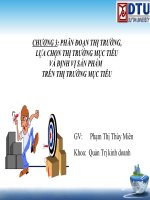Phân đoạn thị trường- Nhắm mục tiêu & Psitioning doc
Bạn đang xem bản rút gọn của tài liệu. Xem và tải ngay bản đầy đủ của tài liệu tại đây (228.94 KB, 23 trang )
1
Part Three:
Market Segmentation
Targeting & Psitioning
( Chapter8)
2
Market segmentation
1. Identify bases for
segmenting the
market .
2. Develop profiles of
resulting segments .
Market segmentation
1. Identify bases for
segmenting the
market .
2. Develop profiles of
resulting segments .
Market targeting
3.Develop measures of
segment attractiveness.
4.Select the target
segment(s).
Market targeting
3.Develop measures of
segment attractiveness.
4.Select the target
segment(s).
Market positioning
5. Develop positioning
for each target segment.
6.Develop marketing
mix for each target
segment.
Market positioning
5. Develop positioning
for each target segment.
6.Develop marketing
mix for each target
segment.
STP Strategies (P.239)
3
Major Segmentation Variables for
Consumer Markets (P.240)
•
Geographic
Region
Country size
City size
Density
Climate
Geographic
Region
Country size
City size
Density
Climate
Demographic
Age Gender
Life cycle
Family size
Income
Occupation
Education
…….
Demographic
Age Gender
Life cycle
Family size
Income
Occupation
Education
…….
Psychographic
Social class
Lifestyle
Personality
Psychographic
Social class
Lifestyle
Personality
Behavioral
Purchase occasion
Benefits sought
User status
Usage rate
Loyalty status
Behavioral
Purchase occasion
Benefits sought
User status
Usage rate
Loyalty status
4
Major Segmentation Variables for
Business Markets (P.249)
•
Demographic
Industry
Company size
Location
Demographic
Industry
Company size
Location
Operating variables
Technology
User/nonuser status
Customer capabilities
Operating variables
Technology
User/nonuser status
Customer capabilities
Purchasing approaches
Purchasing function
organization.
Power structure.
Nature of existing
relationships.
General purchase
policies.
Purchasing criteria.
Purchasing approaches
Purchasing function
organization.
Power structure.
Nature of existing
relationships.
General purchase
policies.
Purchasing criteria.
Situational factors
Urgency
Specific application
Size of order.
Situational factors
Urgency
Specific application
Size of order.
Personal characteristics
Buyer-seller similarity
Attitudes toward risk
Loyalty.
Personal characteristics
Buyer-seller similarity
Attitudes toward risk
Loyalty.
5
•
The characteristics of market segments:
(P.250)
•
Measurable; ( 可测定性 )
•
Accessible; ( 可测入性 )
•
Substantial; ( 可测利性 )
•
Differentiable; ( 可测分性)
•
Actionable. ( 可操作性 )
6
Target Marketing
•
Evaluating Market Segments (P.251)
Segment Size
and Growth
Segment Size
and Growth
Segment Structural
Attractiveness
Segment Structural
Attractiveness
Company Objectives
and Resources
Company Objectives
and Resources
Target Markets
Target Markets
7
Target market (P.251)
Target market is a set of buyer sharing
common needs or characteristics that the
company decides to serve.
8
Market Segmentation
Levels of market segmentation (P.252)
Mass
marketing
Mass
marketing
Segment
marketing
Segment
marketing
Niche
marketing
Niche
marketing
Micro-
marketing
Micro-
marketing
9
Mass (Undifferentiated) marketing (无差异异异)
A market-coverage strategy in which a firm
decides to ignore market segment differences and
go after the whole market with one offer .
Segment (Differentiated) marketing (差异异异)
A market-coverage strategy in which a firm
decides to target several market segments and
designs separate offers for each.
10
Selecting Market-coverage strategies
Undifferentiated Marketing
Company
marketing
mix
Company
marketing
mix
Market
Market
11
Selecting Market-coverage strategies
Differentiated Marketing
Company marketing mix1
Company marketing mix1
Company marketing mix2
Company marketing mix2
Company marketing mix3
Company marketing mix3
Segment1
Segment1
Segment2
Segment2
Segment3
Segment3
12
Concentrated marketing (集中异异)
A market-coverage strategy in which a
firm goes after a large share of one or a few
market segments.
Niche marketing (异隙异异)
Focusing on sub-segments or niches with
distinctive traits that may seek a special
combination of benefits.
13
Selecting Market-coverage strategies
•
Concentrated marketing
Company
marketing
mix
Company
marketing
mix
Segment1
Segment1
Segment2
Segment2
Segment3
Segment3
14
Micro-marketing ( 精异异异)
The practice of tailoring products and
marketing programs to suit the the tastes of
specific individual and locations.(includes local
marketing & individual marketing).
Individual-marketing ( 定制异异)
Tailoring products and marketing programs to
the needs and preferences of individual customers.
15
The Factors of Choosing
a Market-Coverage Strategy (P.257)
•
1.Company resources;
•
2.Product variability;
•
3.Product’s stage in the life cycle
•
4. Market variability ;
•
5. Competitors’ marketing strategy.
16
Market Positioning
•
Product position (P.259)
The way the product is defined by consumers
on important attributes ——the place the product
occupies in consumers’ minds relative to
competing products 。
17
Choosing a positioning strategy (P.270)
Choosing
the right
competitive
Advantage
Choosing
the right
competitive
Advantage
Selecting an
Overall
Position
Strategy
Selecting an
Overall
Position
Strategy
Identifying
possible
Competitive
Advantage
18
Competitive advantages
Product
Differentiation
Product
Differentiation
Services
Differentiation
Services
Differentiation
Personnel
Differentiation
Personnel
Differentiation
Image
Differentiation
Image
Differentiation
Channel
Differentiation
Channel
Differentiation
19
Choosing the right competitive advantages
How many differences to promote ?
How many differences to promote ?
Which differences to promote?
Important( 重要) Distinctive (特色) Superior( 测先)
Communicable( 测通) Preemptive( 测有)
Affordable( 可测) Profitable( 有利)
Which differences to promote?
Important( 重要) Distinctive (特色) Superior( 测先)
Communicable( 测通) Preemptive( 测有)
Affordable( 可测) Profitable( 有利)
20
Selecting a overall positioning
strategy(P.263)
Value proposition:
The full positioning of a brand — the
full mix of benefits upon which it is
positioned.
21
Possible value propositions ( P.263 )
More
for
more
More
for the
same
More
for
less
The same
for
less
Less for
much
less
More
More
The same
The same
Less
Less
Price
Benefits
22
Positioning statement (P.265)
A statement that summarizes company or
brand positioning – it takes this form:
To (target segment and need)
Our (brand)
Is (concept)
That (point-of-difference)
23
Communicating & delivering the chosen position
(P.267)
Company
Company
Chosen position
Chosen position
Target
customer
Target
customer
Product, Price, Place, Promotion
Communicating
Delivering









